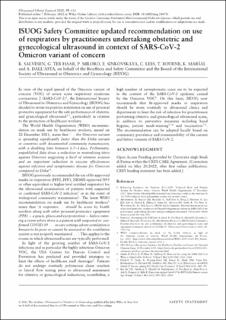| dc.description.abstract | In view of the rapid spread of the Omicron variant of concern (VOC) of severe acute respiratory syndrome coronavirus 2 (SARS-CoV-2)1, the International Society of Ultrasound in Obstetrics and Gynecology (ISUOG) has decided to revise its position statements on use of personal protective equipment for the safe performance of obstetric and gynecological ultrasound2, 3, particularly in relation to the protection of healthcare workers.
The World Health Organization (WHO) recommendation on mask use by healthcare workers, issued on 22 December 2021, states that ‘…the Omicron variant is spreading significantly faster than the Delta variant in countries with documented community transmission, with a doubling time between 1.5–3 days. Preliminary, unpublished data show a reduction in neutralizing titres against Omicron suggesting a level of immune evasion and an important reduction in vaccine effectiveness against infection and symptomatic disease for Omicron compared to Delta’4.
ISUOG previously recommended the use of fit-approved masks or respirators (FFP2, FFP3, NIOSH-approved N95 or other equivalent or higher-level certified respirator) for the ultrasound examination of patients with suspected or confirmed SARS-CoV-2 infection3 or in the event of widespread community transmission2. The latest WHO recommendation on mask use by healthcare workers1 states that ‘A respirator… should be worn by health workers along with other personal protective equipment (PPE) – a gown, gloves and eye protection – before entering a room where there is a patient with suspected or confirmed COVID-19 … in care settings where ventilation is known to be poor or cannot be assessed or the ventilation system is not properly maintained…’. This applies to the rooms in which ultrasound scans are typically performed.
In light of the growing number of SARS-CoV-2 infections and in particular the highly infectious Omicron VOC, the USA Centers for Disease Control and Prevention has predicted and provided strategies to limit the effects of healthcare staff shortages5. Patients do not undergo routinely polymerase chain reaction or lateral flow testing prior to ultrasound assessment for obstetric or gynecological indications, nonetheless, a high number of asymptomatic cases are to be expected in the context of the SARS-CoV-2 epidemic caused by the Omicron VOC6. On this basis, ISUOG now recommends that fit-approved masks or respirators should be worn routinely in ultrasound clinics and departments to limit the risk of infection for practitioners performing obstetric and gynecological ultrasound scans, in addition to preventive measures including hand hygiene, patient mask-wearing2-4 and vaccination7, 8. The recommendation can be adapted locally based on community prevalence and transmissibility of the current and future variants of SARS-CoV-2. | en_US |

